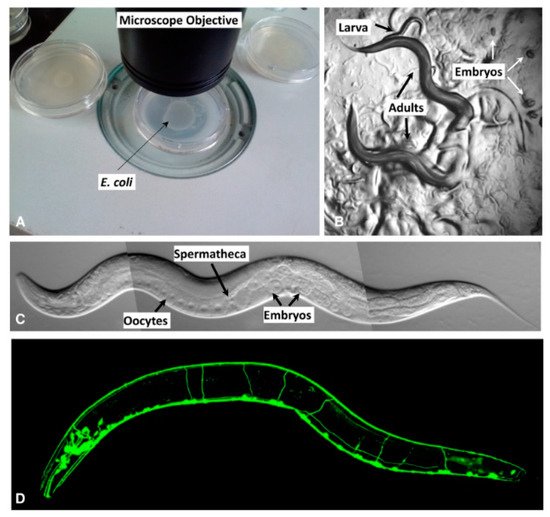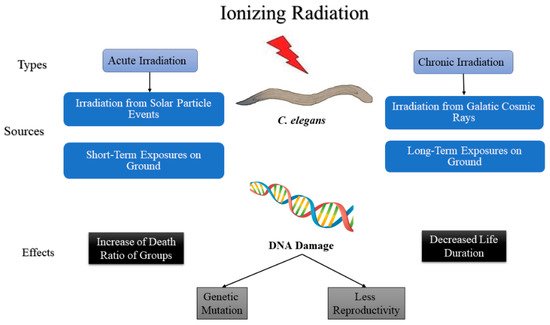Knowledge regarding complex radiation responses in biological systems can be enhanced using genetically amenable model organisms. In this manuscript, we reviewed the use of the nematode, Caenorhabditis elegans (C. elegans), as a model organism to investigate radiation’s biological effects. Diverse types of experiments were conducted on C. elegans, using acute and chronic exposure to different ionizing radiation types, and to assess various biological responses. These responses differed based on the type and dose of radiation and the chemical substances in which the worms were grown or maintained.
- ionizing radiation
- acute and chronic exposure
- dose
- biological dosimeter
- Caenorhabditis elegans
Note: The following contents are extracted from your paper. The entry will be online only after author check and submit it.
1. Introduction

3. Acute and Chronic Irradiation in C. elegans

3.1. Space vs. Ground Experiments
3.2. Effect on Aging
3.3. Effect on Reproduction
3.4. Effect on DNA Response
| Type of Radiation and Exposure Time | Radiation Dose/Dose Rate | Findings | Year/ Studies |
|---|---|---|---|
| Gamma Radiation for about an hour | 0.027 Gy/min | ≥0.1 Gy is needed to reduce the mean life of C. elegans. Dauers are the most sensitive and 8-day-old adults are the most resistant to ionizing radiation. |
Johnson et al., 1984 [36] |
| Targeted micro bream (12C ion particles) | 20, 40, 60, and 100 Gy | Reproduction in C. elegans eggs arrested for both whole body and tip irradiation. In spot irradiation, the neighboring cells around the targeted point did not arrest the reproduction of germ cells nor did apoptosis happen. |
Sugimoto et al., 2006 [76] |
| Gamma radiation | 100 Gy (32 Gy/min) | Chemotaxis reaction of C. elegans toward NaCl decreases. The role of ionizing irradiation in associative learning of C. elegans toward NaCl is elaborated. |
Sakashita et al., 2008 [69] |
| Funayama et al., 2020 [ | |||
| 74 | |||
| ] | |||
| Gamma Radiation | |||
| 0, 5, 10, 25, and 50 Gy (3.37 Gy/min) | |||
| Germ cell apoptosis decreases when | |||
| C. elegans | |||
| Vujin et al., 2020 [ | |||
| 84 | |||
| ] | |||
| Type of Radiation & Exposure Time | Radiation Dose | Findings | Year/Studies | ||||
|---|---|---|---|---|---|---|---|
| Low dose gamma-ray radiation for 219.5 h | 61 | ] | |||||
| Low dose gamma-ray radiation for 11 days | Not specified | No significant increase in the mutation rate Introduction of eT1 balancer system for longer-term measurement of biological damage in space. |
|||||
| are treated with Ceramide. | |||||||
| Ceramide influences | |||||||
| C. elegans | |||||||
| ’s response to DNA damage. | |||||||
| Ceramide involves in the functioning of mitochondria in | |||||||
| C. elegans | |||||||
| under ionizing irradiation. | |||||||
| Yang et al., 2020 [ | |||||||
| 85 | |||||||
| ] | |||||||
| 0.268 to 0.306 cGy | The mutation frequency increased significantly due to exposure to space radiation. | The charged iron particles are the major mutagenic component and the increased mutation frequencies caused significant cancer risk inherent in extended space travel. |
Hartman et al., 2001 [Zhao et al., 2006 [62] | ||||
| Gamma radiation for 4 h | 100 Gy (0.42 Gy/min) | The avoidance response of C. elegans toward NaCl decreased significantly. | Sakashita et al., 2008 [69] | Gamma radiation for 18 s | 6 × 10−3 to 2.8 × 10−2 Gy (for 1 month) 36 × 10–3 to 16.8 × 10–2 Gy (for 6 months) 144 × 10–3 to 67.2 × 10–2 Gy (for 2 years) |
||
| Accelerated proton for 18 s | 33.6 × 10–3 to 16.8 × 10–2 Gy (for 6 months) 144 × 10–3 Gy (for 2 years) | C. elegans would experience some damage from irradiation during long-term space flight, there are changes in genes related to DNA damage response, oxidative stress, and cell death, and the gamma rays induce apoptosis. | DNA repair mechanism was reduced due to proton exposure. Accelerated protons induce the expression of genes that are related to the DNA damage response and anti-apoptosis.S. Yi et al., 2013 [64] |
||||
| Yi et al., 2013 [ | 64 | ] | Accelerated proton for 18 s | 33.6 × 10–3 to 16.8 × 10–2 | |||
| Gamma Radiation (137Cs source) for 64 h | Gy (for 6 months) 144 × 10–3 Gy (for 2 years) |
DNA repair mechanism was reduced due to proton exposure. Accelerated protons induce the expression of genes that are related to the DNA damage response and anti-apoptosis. |
S. Yi et al., 2013 [64] | ||||
| Dose rate 7 and 52 mGy/h | Dose: 0.5 and 3.3 Gy |
Life span is significantly shortened in irradiated C. elegans. There was a significant difference between different absorbed doses for the same dose rate. |
Kuzmic et al., 2019 [70] | Gamma radiation | 25, 50, 60, 90, 120 Gy | 53BP1 homolog, HSR-9 increases the cell death in muted | |
| Gamma Radiation (137Cs source) for 19 days |
Dose rate 7 and 52 mGy/h Dose: 3.3 and 24 Gy | C. elegans exposed to acute irradiation. HSR-9 does not involve in C. elegans cells’ response to DNA damage due to ionizing irradiation. |
Life span is significantly shortened in irradiated C. elegans. Ryu et al., 2013 [82] |
||||
| There was a significant difference in absorbed doses in the treatments between 3.3 Gy cumulative irradiation (with 7 mGy/h) and 24 Gy cumulative irradiation (with 52 mGy/h) | Kuzmic et al., 2019 [ | 70 | ] | Proton particles microbeam | Ionized irradiation causes bystander effects in C. elegans cells |
||
| Gamma Radiation (137Cs source) for 65 h | 1.65, 6.6, 16.5, 33 and 66 Gy (0.033 Gy per proton particle) | Six dose rates 7, 14, 45, 50, 75, and 100 mGy/h Dose: 0.5, 1, 3.3 GyProton irradiation increases the germ cell apoptosis in neighboring cells around the radiation spot. | Guo et al., 2013 [66] | ||||
| There are no effects from irradiation on the percentage of the hatch after chronic irradiation compared to control | C. elegans | . | Dubois et al., 2018 [88] | Proton microbeam and gamma rays (137Cs) (Time not specified) |
Proton bream: 3.2 MeV with linear energy transfer rate Gamma rays: 75 and 100 Gy |
||
| Gamma radiation (137Cs source) for 65 h | DNA damage in worms was unique and in somatic cells, which include vulval cells the DNA damage checkpoint was not active. | Radio-adaptive responses of the whole C. elegans organisms were improved by bystander effect, which was induced by radiation. |
Tang et al., 2016 [ | Dose rate: 7, 14, 50 mGy·h−1 corresponding to cumulated doses (0.5, 1, and 3.3 Gy)67] | |||
| 168 proteins were found with significant differences. | The molecular mechanisms induced by chronic irradiation differ from those that were induced by acute irradiation. | Dubois et al., 2019 [71] | Targeted micro bream (12C ion particles) | 500 Gy | Development of a method to irradiate active C. elegans. Whole-body irradiation decreased the movement rate of C. elegans significantly. Regional irradiation on the head, middle, and tail of C. elegans did not have a significant effect on the movement rate. |
Suzuki et al., 2017 [72] | |
| Gamma Radiation for 62 h | Dose rate: 0.9 to 227 mGy·h−1 Total dose up to 228 Gy |
The number of larvae hatched was significantly decreased (by 43 and 61%, when chronically exposed from egg to young adult stage to a total dose of 6.7 Gy and 14 Gy, respectively) with increased germ cell apoptosis, impaired sperm meiosis, and adverse effects on sperm production. | Maremonti et al., 2019 [90] | Gamma radiation (137Cs) | 0, 60, 90, and 120 Gy | Ionized irradiation caused significant damage in C. elegans DNA but did not reduce the reproduction cells. Sensitivity to ionized irradiation increased in C. elegans mutants compared to the wild-type strain. BUB has a role in the response of C. elegans to DNA damage. |
Bertolini et al., 2017 [83] |
| Gamma Radiation for 72 h | Dose rate: 0.4 to 100 mGy Dose: 0.03 to 72 | Significant increase in mtDNA copy number (approx. 1.6-fold). | Maremonti et al., 2019 [90] | Gamma radiation (137Cs) | 2.5, 6.5, 14.4, 50, 100, and 200 Gy | Dependency of hatchability on irradiation dose was shown by the result of the decrease in significant number of progenies per individual after irradiation from and above 50 Gy, until 200 Gy. | Dubois et al., 2018 [88] |
| Gamma Radiation for 96 h | Dose rate: 40 and 100 mGy·h−1 Total dose: ~3.9 and 9.6 Gy |
Toxic effect in reproduction. No of offspring reduced by 20 and 40%. |
Maremonti et al., 2020 [91] | Gamma radiation (137Cs) | 1 Gy·min−1 0.5 Gy, 1 Gy, and 3.3 Gy |
369 proteins were found with significant differences. The molecular mechanisms induced by chronic irradiation differ from those induced by acute irradiation. |
Dubois et al., 2019 [71] |
| X-ray (600C/D linear accelerator) | 0 gray [64], 200 Gy, and 400 Gy (not specified) | Genes related to several biological processes, such as behavior, regulation growth and locomotion, positive regulation of growth, calcium ion transport, and di- and trivalent inorganic cation transport, are differentially expressed | Xu et al., 2019 [68] | ||||
| Gamma Radiation | Dose Rate: 1445 mGy·h−1 Total dose up to 6 Gy |
Acute irradiation does not induce a significant change in reproduction. | Maremonti et al., 2019 [89] | ||||
| Targeted micro bream (12C ion particles) | 0, 500, 100, and 1500 Gy | The decrease in mortality depends on the dose due to central nervous system (CNS) targeted irradiation and may partly be due to body-wall muscle cells around the CNS. | Suzuki et al., 2020 [73] | ||||
| Targeted micro bream (12C ion particles) | 500 Gy | Targeted heavy ion microbeam smaller than 10 µm. The preparation and irradiation method for the device is provided. Targeted irradiation on the specific spots did not have an impact on the movement of C. elegans. |
X-ray | 0, 25, 37.5, 50, and 75 Gy | NHEJ factor in C. elegans is reported. NHJ-1 causes ionized radiation sensitivity in N2 wild-type C. elegans. |
